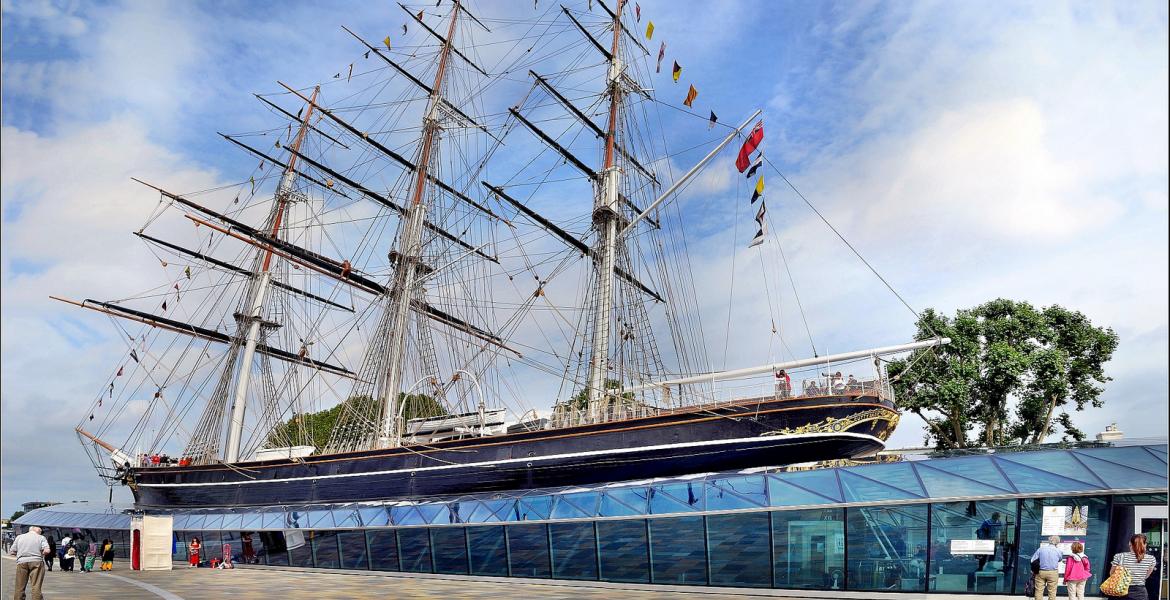The Cutty Sark, Greenwich, London
Dry docked, and raised three metres off the floor, at Greenwich, the Cutty Sark was one of the last – and one of the fastest – wind powered tea clippers. Designed to sail from London to China and back again faster than her competitors, her speed would have let crew gain a greater return on their cargo of tea, as the first delivery of the season was always bought at a premium. Sadly, she was hit by a run of misfortune and never won the tea race in any of her eight voyages for this purpose. She was built and launched in 1869, in the same year as the Suez Canal was opened, and right before the dawn of steam ship superiority. The Suez Canal shortened the route to China by 3,000 miles, but the winds in the Mediterranean did not suit sail power, and thus steam ships were favoured. The Cutty Sark then transported wool to Australia, before being bought by a Portuguese firm and renamed the Ferreira. She limped into Falmouth after a storm in the Channel in 1922, where she was seen and ultimately bought (for £3750, which was vastly overpriced) by Wilfred Dowman. On his death, she was given to the nation and turned into a training ship, before being taken in 1954 to Greenwich and restored to her original appearance, where she has been a tourist attraction ever since.
The Suez Canal shortened the route to China by 3,000 miles, but the winds in the Mediterranean did not suit sail power, and thus steam ships were favoured. The Cutty Sark then transported wool to Australia, before being bought by a Portuguese firm and renamed the Ferreira. She limped into Falmouth after a storm in the Channel in 1922, where she was seen and ultimately bought (for £3750, which was vastly overpriced) by Wilfred Dowman. On his death, she was given to the nation and turned into a training ship, before being taken in 1954 to Greenwich and restored to her original appearance, where she has been a tourist attraction ever since.
The Cutty Sark does its best to introduce visitors to life on board a sail ship during the mid-nineteenth century. Everything has been restored well, and good use has been made of the ship’s hold, with well-presented information and plenty of hands-on activities for children (of all ages) as well as interactive displays (including a rocking seat to experience life on a rolling ship at sea). The children, therefore, absolutely loved the visit, despite being sometimes too young for other exhibitions. Fears of it being overcrowded were quickly overcome by the ticketing system, which allowed only a certain number of visitors to enter in any given amount of time. Whilst this added considerably to queuing before entry, it made the experience much better, without being herded along by the crowd or struggling to see over people’s heads.
There was, therefore, absolutely nothing to complain about during the visit, apart perhaps from the cost of the ticket (£13.50 for an adult and £7 for a child with donation), which is quite expensive given the amount of time spent on the ship (no more than an hour and a half). Accessibility was catered for with a lift running the height of the ship, and there were good facilities (including an overpriced café and gift shop), although as with most venues in London, there was no parking connected to it. The ship and its museum did everything it set out to do, but potentially lacked that je ne sais quoi to make it a star attraction, not being historically significant and the visit being over quite quickly. However, when combined with the other museums at Greenwich (many of which are free, but for which a big ticket covering all of them can be bought - £18.50 per adult and £8 per child including a donation), it makes an interesting and engaging part of the trip.
You can find out more about the Cutty Sark here.
- Log in to post comments







